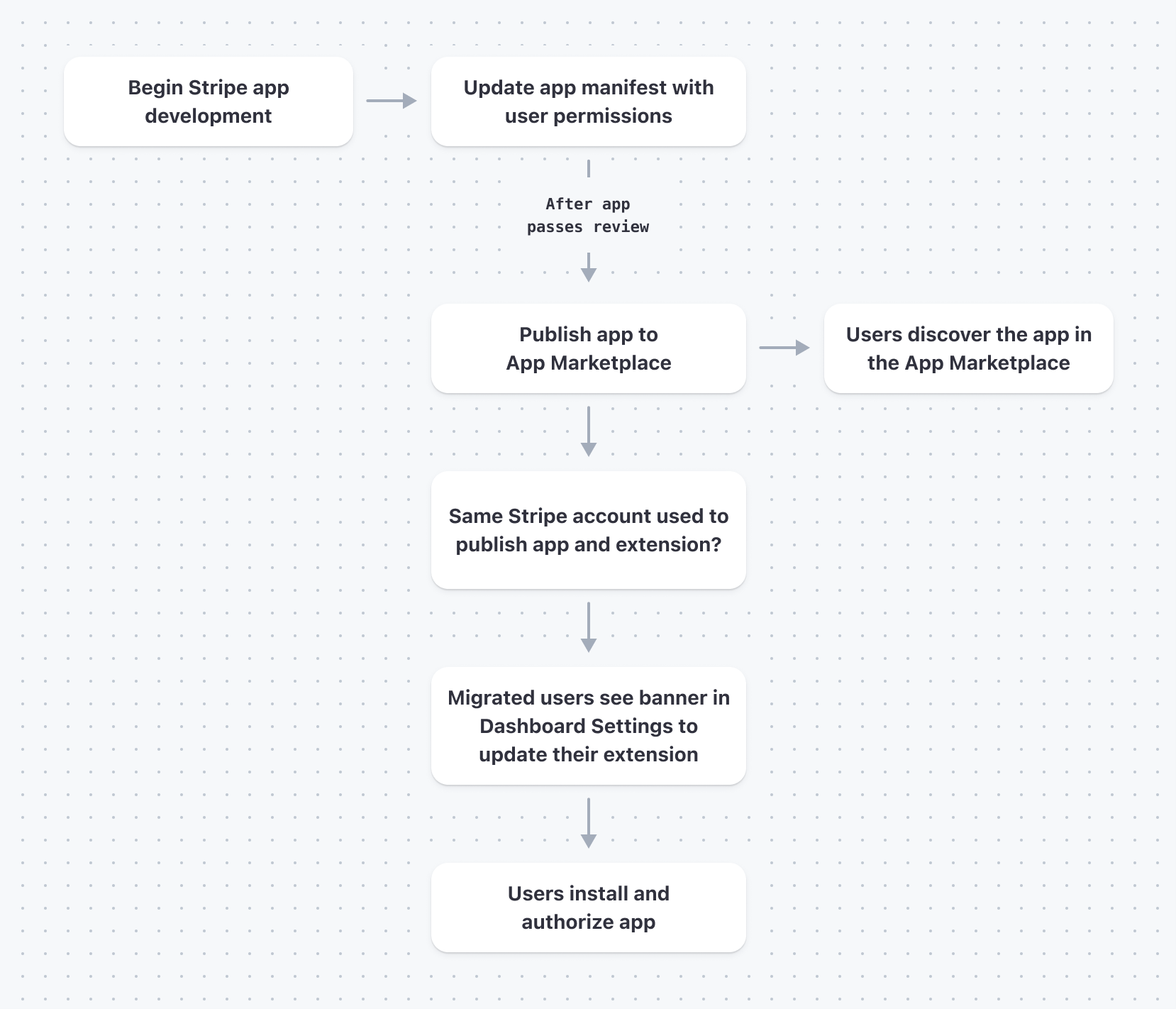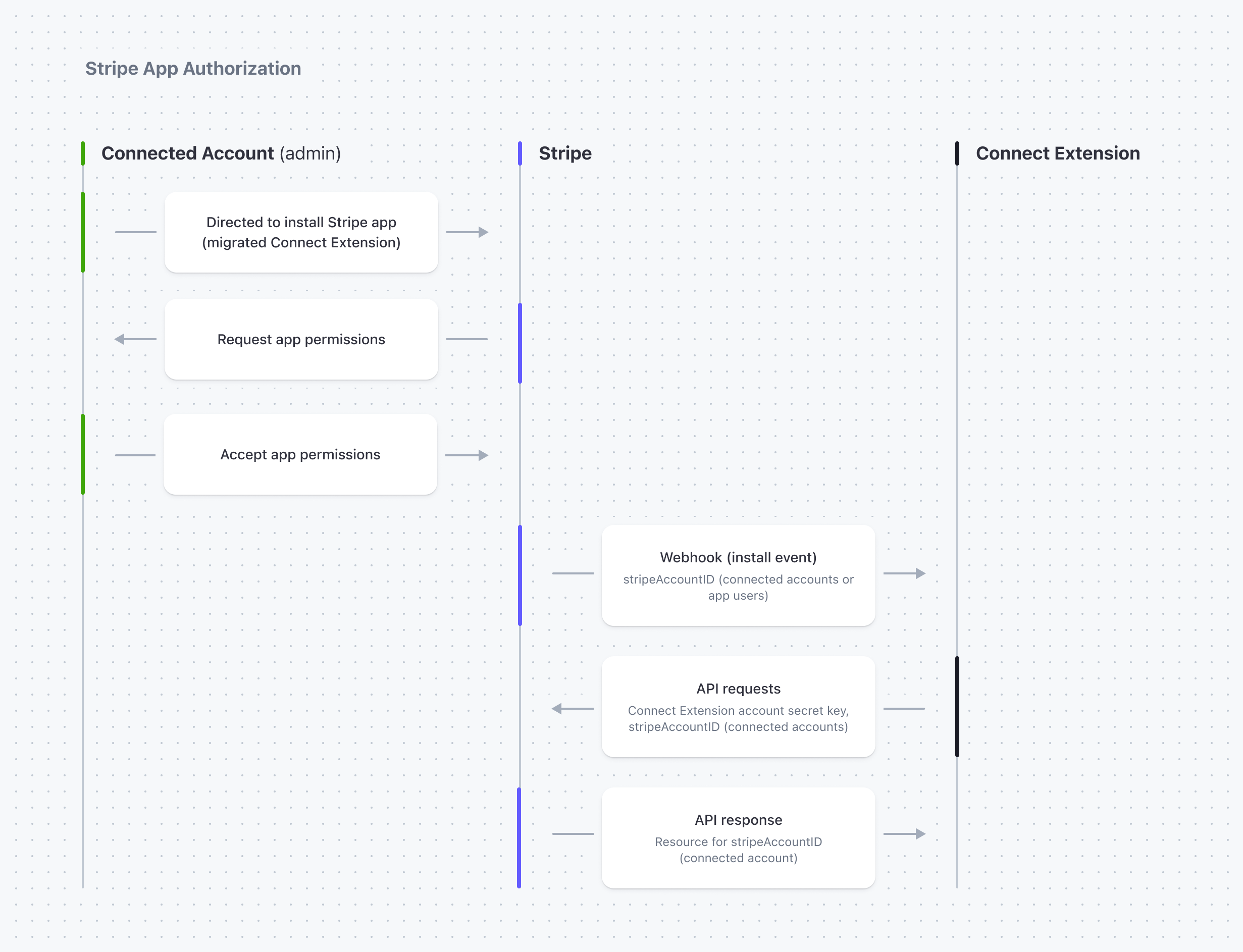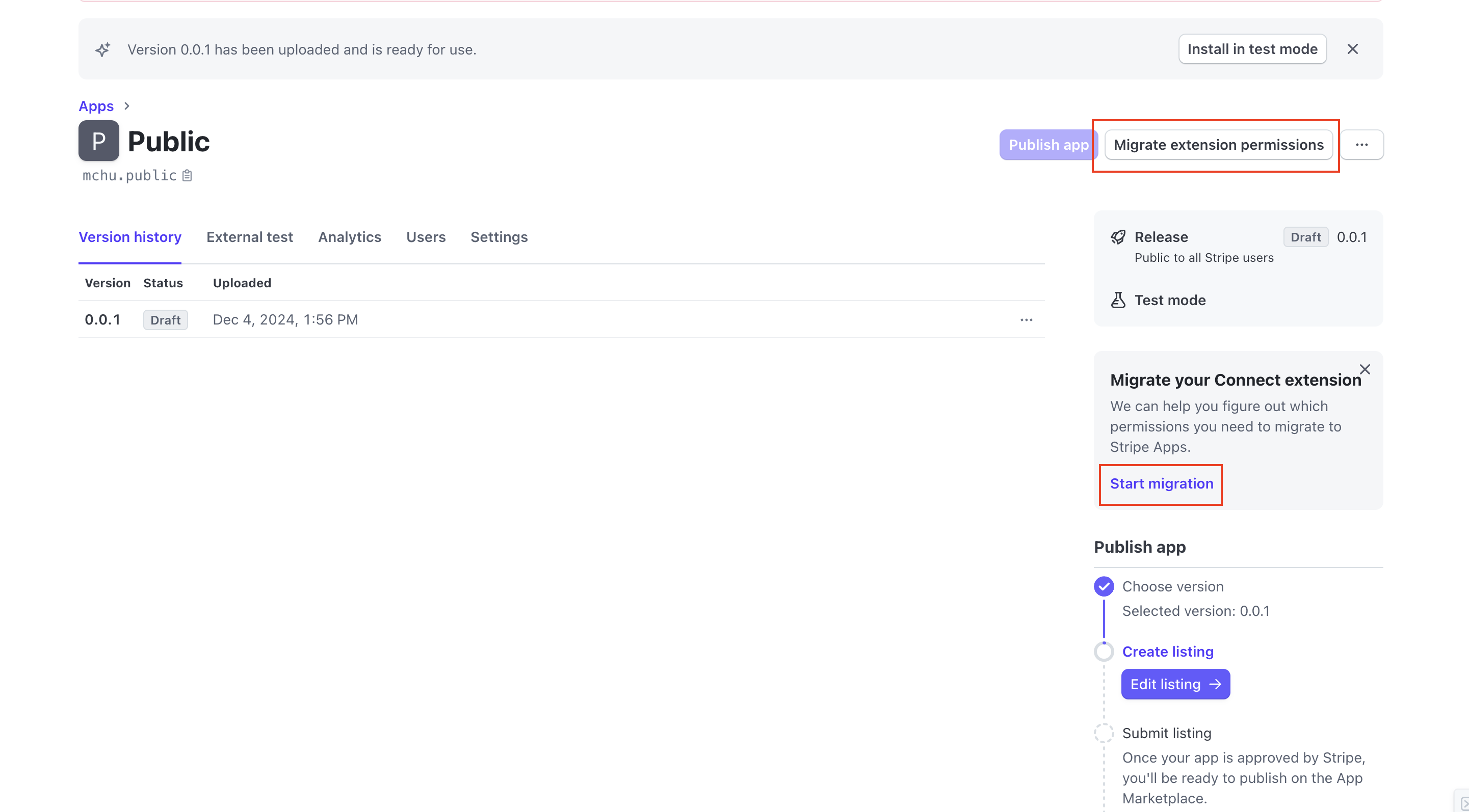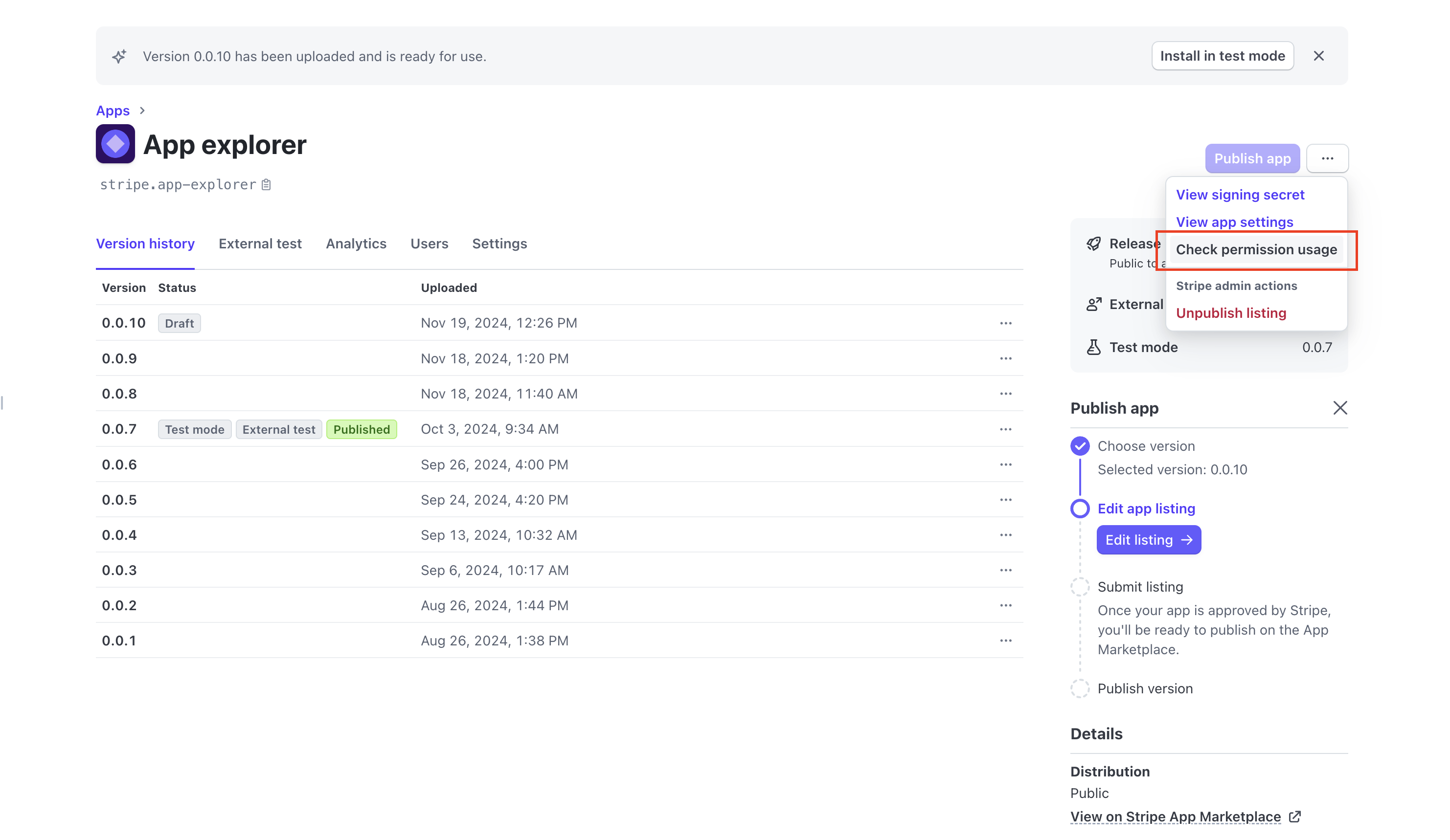Migrate an extension to Stripe Apps
Learn why and how to migrate your extensions to Stripe Apps.
Extensions are legacy apps built on Stripe, available to Stripe users in the Partner Directory. Through OAuth and API requests, they bring payments data into other business tools, like analytics dashboards or data warehouses.
Stripe Apps replaces extensions as the preferred way to integrate Stripe with other tools. Stripe will redirect users from the Partner Directory to discover apps on the Stripe App Marketplace.
After May 24, 2022, you can no longer create new extensions. On August 31, 2022, Stripe will remove all mentions of extensions on the Partner Directory. If you own an extension, migrate to Stripe Apps now to ensure continued discoverability.
Reasons to migrate 
Stripe Apps is an upgrade from the current extensions. By migrating, you get the following:
- Better discoverability, with broad visibility in the Stripe Dashboard and the Stripe App Marketplace
- More granular permissions, so you can set (and your users can understand) what data and APIs an app can access
- Interactive functionality, with embedded UI components in the Stripe Dashboard (so users can interact directly with your app without leaving Stripe)
- No interruption to your existing extension users if they choose to migrate
What happens if you don’t migrate 
If you choose not to migrate your extension to a Stripe App, your extension will continue to work as it does today, without impact to users until 2024. We’ll continue to support extensions on our backend until the end of 2024. However, new users won’t be able to find any mention of extensions in the Partner Directory starting August 31, 2022.
Stripe Apps vs. extensions 
An app can do everything an extension does, with two key additions:
- Interactive functionality, using embedded UI components in the Stripe Dashboard
- More granular permissions to help users understand what an app can access
The other difference is that any user can discover apps from the Stripe App Marketplace instead of the Partner Directory.
| Extensions | Stripe Apps |
|---|---|
| Any Stripe user can use. | Any Stripe user can use. |
| After August 31, 2022, Stripe will remove all mentions of extensions from the Partner Directory. | Discoverable in the Stripe App Marketplace, with better visibility to all Stripe users. |
| You can find your existing extensions in the Dashboard, under Developers > Extensions. | You can find your apps in the Dashboard, under Developers > Apps. |
| Extensions are limited to either all read or all write permissions. No support for granular permissions. | You can request a granular set of permissions from users as part of app installation. |
| You can’t create new extensions after May 24, 2022. | Any developer can build on Stripe’s platform. |
| After users link their Stripe accounts to your extension with OAuth, you can make API requests on their behalf. | After users authorize and install your app, you can make API requests on their behalf. |
| Users interact with your extension by installing additional tools and leaving Stripe. | Users can interact with your app within the Stripe UI without leaving Stripe. |
| No ability to extend the Stripe UI. | You can build directly on top of the Stripe UI, starting with the Stripe Dashboard. |
Impact on your extension’s users 
After migrating your extension, your existing users will see a badge in their extension settings page prompting them to re-authenticate. Your users must accept permissions to begin using your migrated app. If they choose not to accept permissions, they can continue to use their extension uninterrupted until 2024.
Migrating lets you keep your existing extension code on the Stripe account you’re already using. You can’t have both an existing extension and a Stripe app on the same Stripe account—you can only have either an extension or an app. If you choose to migrate, you must migrate using the Stripe account linked to your extension. Using the same Stripe account also ensures continuity in the user experience, and users only need to accept a prompt in the Stripe Dashboard to switch from an extension to your new app.
If you don’t want to migrate your extension, and you still want to create an app, you will encounter several restrictions:
- You must create another Stripe account to publish the app.
- The app must have a unique and different purpose than your existing extension’s service.
Migrate to Stripe Apps 
Follow the steps below to migrate your extension to a Stripe App.

Migrating an extension to a Stripe App
Before you begin
- To protect your extension’s users while you develop your Stripe App, test and upload your app with a separate or new Stripe account to fully separate the app’s users from your extension’s users.
- To add an extra layer of safety, create a separate testing instance of your backend. While testing your Stripe app, avoid making changes to the backend code powering your live extension.
- After you have fully tested your Stripe app, upload the app to the same Stripe account that links to your extension to submit for App Review.
Add interactive functionality
Optionally, you can add interactive functionality in the Stripe Dashboard with UI components:
Add a webhook listener
Make sure your extension can make authenticated requests to Stripe. Add a webhook listener for the account. event.
In addition to the documented response properties in the event object reference, each event for a connected account also contains a top-level account property. This property identifies the user webhook is being sent for.
Each event for a connected account contains the documented response properties in the event object referenceand a top-level account property. The account property identifies the unique user the webhook is being sent for:
{ "id": "evt_bruV5evv5Dbi6a", "livemode": true, "object": "event", "type": "account.application.authorized", "account": "acct_IbQFpF6xAYBpq8", "pending_webhooks": 2, "created": 1349654313, "data": {...} }
The user is now connected to your platform. Store the account in your database—this is the Stripe ID for the new account. You’ll use this value to authenticate as the connected account by passing it into requests in the Stripe-Account header.
For more information, see Connect webhooks.
Add permissions and upload your app
Add permissions to your app manifest and upload your app. After uploading the app, you can use the permission migration tool on the App Details page to view recommended missing permissions. Administrators of your connected accounts must accept these permissions to migrate to your app.
Warning
The permissions model for Stripe Apps will overwrite the global permissions previously accepted by a user that authorized an extension. To ensure your existing users don’t experience permissions related interruptions, you must identify which objects your extension (not your app) calls on the Stripe API to know which permissions to add to your app.
The migration process between your connected account administrator, Stripe, and your extension looks like:

You can find the migration tool by navigating to your app on the App Details page in the Dashboard. The tool exists in multiple locations highlighted below.

Callout and button for unpublished apps

Pushed to overflow menu option when app is published
After your app passes review and you publish your app, your extension’s users must accept permissions in their Dashboard settings to see and use the migrated app. If you add UI extensions, users get redirected to the Stripe App Marketplace to accept changes instead of in the Dashboard.
Publish your app
Submit your app for review and publish it on the Stripe App Marketplace.
To increase your chances of passing app review, adhere to Stripe’s:
Your app must pass app review to list it in the Stripe App Marketplace. When you’re ready to publish your app, use the primary Stripe account you use for live mode traffic so that your extension’s users can migrate to your app.
Onboard users
After migration, your existing users must re-authenticate in the Dashboard to use your Stripe app. If they don’t accept the permissions prompt, they can continue to use your extension uninterrupted until 2024.
You can onboard new users to your Stripe App in two ways:
- You can list your migrated app in the Stripe App Marketplace after migrating your app and passing the app listing requirements. Any Stripe App on the Stripe App Marketplace will be available to install to Stripe account users starting late June 2022.
- New users can continue to onboard to your extension with OAuth from your website. After users accept OAuth authorization and return to the Stripe Dashboard, Stripe prompts them to use your migrated Stripe App instead. If they decline, users can continue using the extension uninterrupted until 2024.
Note
To avoid onboarding new users with OAuth after you complete the migration, you can remove your OAuth callbacks and redirect new users to your app listing on the Stripe App Marketplace by changing your website’s Connect with Stripe button. If you remove OAuth callbacks, you can’t onboard new users until late June 2022, using the Stripe App Marketplace. If you don’t remove OAuth callbacks, you’re responsible for managing the separate listings and users for both your extension and Stripe App.